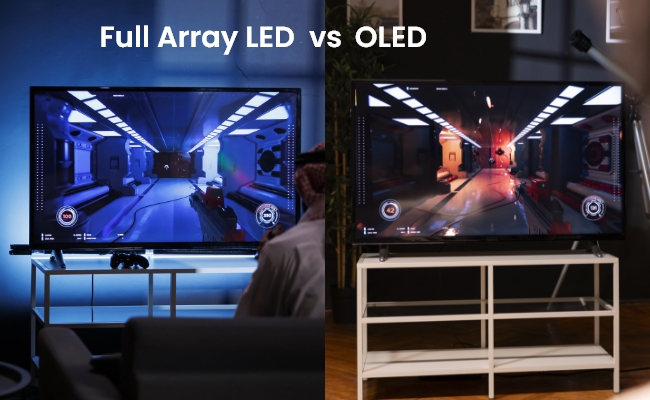Full Array LED vs OLED: A Detailed Comparison

Once you start looking around for TV options, you’ll see terms like Full Array LED, OLED, and Mini LED. All have their own special strengths and weaknesses. Full Array LED and OLED have some differences and different performances, and both have advantages and disadvantages depending on your needs. Let us explore which one of the Full Array LED vs. OLED TV options is the right pick for you.
Note: Don’t miss Reolink’s Black Friday and Cyber Monday deals for exclusive discounts on security cameras!
Reolink New Year Sale - Save Big with Exclusive Deals!
Save big with Reolink! New Year Sale up to 45% off on security cameras, doorbells, and systems — Dec. 8 to Jan. 4.
Full Array LED vs OLED: Basic of Full Array LED
First, let us get into the technicalities of Full Array LED TVs and their working.
What is Full Array LED?
Full Array LED TV means LEDs not just on the edges but across the back of the screen. Such a setup provides better uniform backlighting, and therefore brightness, contrast, and color consistency across the entire screen.
How does Full Array LED work?
In a Full Array LED TV, the LEDs are arranged in clusters or zones. The image controls which brightens or dims each zone independently. One capability that is referred to as local dimming allows it to increase contrast, dimming the dark areas and brightening the light areas.
Pros and Cons of Full Array LED
Below are the positives and negatives of Full Array LED TVs:
Pros:
- Better brightness
- Better contrast
- No risk of burn-ins
Cons:
- Limited black performance
- Limited viewing angles
Full Array LED vs OLED: Basic of OLED
Now, let us look at the technicalities of OLED TV technology.
What is OLED?
Organic Light Emitting Diode is the acronym for OLED. LED (light emitting diode) doesn’t need a backlight since each pixel lights up independently of others, whereas OLED (organic light emitting diode) pixels emit light on their own like LEDs do, without backlight. So, it delivers true blacks, deeper contrast, and more stunning picture quality.
How does OLED work?
OLED TVs use organic compounds that when electricity is run through them, light them up. Because each pixel can be on or off independently, deep blacks are achieved simply by turning off pixels where there are dark areas.
Pros and Cons of OLED
Here are the pros and cons of OLED TVs:
Pros:
- Wide viewing angles
- Perfect black performance
- High color accuracy
Cons:
- Risk of burn-ins
- High cost
Full Array LED vs OLED: What's the Difference?
There are some crucial differences between Full Array LED vs OLED. Full Array LED TVs excel in brightness and durability, making them ideal for well-lit rooms and long-term use. OLED TVs, on the other hand, deliver superior contrast, deeper blacks, and better color accuracy, especially in low-light environments.
Brightness and HDR Performance
Full Array LED screens are very bright so they're perfect for rooms with plenty of natural light. OLED TVs, though, are leagues better in rooms with normal or low light producing deeper blacks and sharper HDR. It adds more detail and contrast especially when compared to Full Array LED.
Contrast and Black Levels
OLEDs give perfect black levels because each of the OLED's pixels can be turned off in a dark scene. Local dimming is a good contrast on full array LED TVs, but they are less deep in black levels compared to OLED. That difference, meanwhile, can mean OLED provides more lifelike shadows and depth in low-light scenes.
Color Accuracy and Depth
Full Array LED and OLED both have accurate colors. However, OLED does a better job of maintaining color depth and richness in the dark scenes. When viewed from the side, Full Array LEDs may lose some of the color vibrancy as compared to OLED.
Durability and Lifespan
Full Array LED screens are very durable, don’t suffer from burn-in, and can display static images for long periods of time. But OLED TVs are still prone to burn in with static content. Full Array LEDs are generally longer lasting when used heavily.
Full Array LED vs OLED: Which One Should You Choose?
What you choose depends on the usage and priorities of your viewing environment. A Full Array LED TV would be better if you watch TV in a lighted room. OLEDs do fare excellently with deep blacks and contrast for dimly lit rooms or even home theater.
For lack of burn concerns, Full Array LED is the correct choice for durability. OLED is worth the investment if high-quality contrast and wide viewing angles are most important.
OLED TV vs Full Array LED TV
Full Array LED and OLED TVs can be had from brands like Sony. Sony offers a Full Array LED TV range which is renowned for its great brightness and color accuracy. Black levels, contrast, and viewing angles are much better on their OLED models.
If you’re in a bright room, their Full Array LED is better and if you prefer to watch cinema in a darker space, their OLED is better.
OLED vs Full array LED for Game
Full Array LED TVs are good for gaming, and OLED TVs are great gaming TVs. Full Array LED TVs provide brighter images and minimize motion blur, making them ideal for fast-paced games. The OLED TVs produce deeper blacks and high contrast, bettering graphics in darker games.
On the other hand, static game elements cause the risk of burn-in for OLED. However, this is a problem for the older models, while newer models with features like variable refresh rates, or VRR, reduce the risk of burn-ins.
Full Array LED vs OLED vs Mini LED: What's the Difference?
Another new addition to the industry is Mini LED technology and below is all you need to know about it:
What is a Mini LED?
Mini LED is an advanced form of Full Array LED technology, employing smaller LEDs for backlighting. More precise local dimming meant that more precise levels of contrast and brightness can be achieved, than with a standard Full Array LED TV.
Comparison Table
FAQs
1. Is Full Array LED better than QLED?
If you’re a fan of dark room viewing, the Full Array LED delivers better contrast and local dimming for deeper blacks. QLED offers brighter color and better brightness that will be suited for bright rooms. So, Full Array LED is better for darker rooms and better blacks while QLED is better if you prefer brightness and vibrance.
2. Is Full Array LED worth it?
If high brightness and contrast are a priority, but not the price of OLED, Full Array LED TVs are worth the cost. They’re also great for bright rooms, taking a medium price for a quality experience.
Conclusion
Go for full Array LED TVs as they're good for a bright room that prioritizes consistent performance, and OLED if you want to get close to a cinematic experience with perfect black levels.
At the mid-point, the Mini LED strikes, giving some of the benefits of contrast that are found in OLED tech with LEDs. Since each option in the Full Array LED vs OLED comparison brings unique advantages and disadvantages, you must choose one according to your requirements.
Search
Subscribe for the Latest Updates
Security insights & offers right into your inbox

